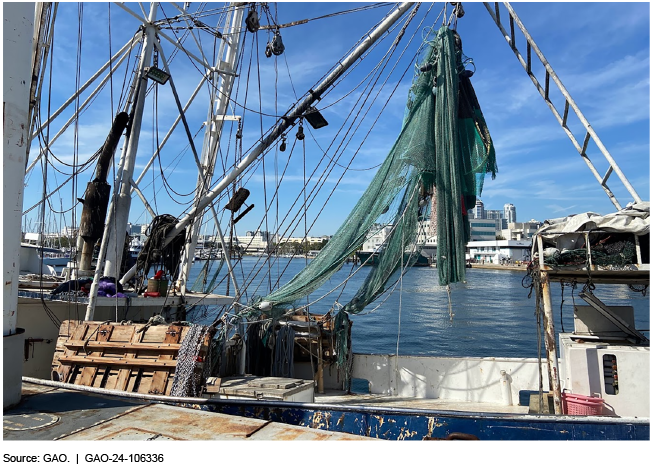Federal Fisheries Management: Efforts to Reduce and Monitor Unintentional Catch and Harm Need Better Tracking
Fast Facts
The National Marine Fisheries Service tries to minimize bycatch—marine life unintentionally caught or harmed by fishing. Fisheries observers deploy on fishing vessels to count bycatch and NMFS uses this data to make bycatch estimates.
But the percentage of fishing trips with observers varies, and estimates are less reliable for fisheries with fewer observers. For instance, only 2% of the fishing trips in the Gulf of Mexico shrimp trawl fishery have an observer.
NMFS said that it needs more funding to recruit and retain observers, but it hasn't communicated those resource needs to Congress.
We recommended, among other things, that it do so.
Shrimp Trawl in the Gulf of Mexico

Highlights
What GAO Found
Bycatch is fish and other marine species that are unintentionally caught or harmed by fishing activities. Fishers try to reduce bycatch with measures that are highly individualized due to the unique interactions among the fish species they are trying to catch, bycatch species, and fishing gear. Such measures can include fishing gear modifications and fishing area closures.
Data on bycatch are primarily collected by fisheries observers, who deploy on fishing vessels to count or weigh bycatch. The percentage of fishing trips carrying observers varies widely by fishery, from zero to 100 percent. National Marine Fisheries Service (NMFS) officials reported that differences in observer funding can drive this variation, and that limited funding for observer coverage complicates bycatch data collection in some fisheries, as discussed below. They also reported challenges with recruiting and retaining observers.
The process for developing bycatch estimates varies across fisheries. It generally involves extrapolating data from a subset of fishing trips with observers to generate bycatch estimates for a whole fishery. GAO found that developing estimates is more complicated and less reliable for fisheries with fewer observers and more limited data. NMFS and Regional Fishery Management Council officials said they use estimates to inform their management decisions. NMFS, however, has not gathered information from all regions on the resources they need to support observer programs, or communicated this information externally to stakeholders, such as Congress. By doing so, NMFS could ensure that stakeholders are more informed when making resource decisions.
Shark Bycatch and Fisheries Observers Working aboard a Fishing Vessel

NMFS' efforts to track its performance in reducing and monitoring bycatch do not align with key elements of evidence-based policymaking related to performance management. Specifically, the agency's bycatch reduction implementation plan lacks measurable performance goals. Having an updated plan with measurable goals and a tracking process could help inform agency decision-making. Additionally, NMFS has enhanced its database to compile bycatch estimates but does not have a comprehensive written plan for how it will report the estimates. Developing such a plan could help the agency better monitor bycatch levels, trends, and information gaps, and demonstrate progress over time to internal and external stakeholders.
Why GAO Did This Study
Bycatch is a complex issue that can threaten the sustainability of fishing communities and ocean ecosystems. Under the Magnuson-Stevens Fishery Conservation and Management Act, NMFS and the councils are to develop conservation and management measures that, among other things, aim to minimize bycatch and bycatch mortality “to the extent practicable.”
GAO was asked to review efforts to manage bycatch. This report addresses (1) measures used to reduce bycatch, (2) coverage and funding of fisheries observers, (3) how bycatch estimates are developed and reported, and (4) how NMFS tracks its performance towards reducing and monitoring bycatch.
GAO reviewed relevant laws and NMFS policies and documents. GAO interviewed NMFS and council officials and relevant stakeholders, including representatives from the fishing industry and academia. GAO selected five fisheries for a more in-depth review. These fisheries reflect a range of geographic regions, fishing gear types, and key bycatch concerns.
Recommendations
GAO is making four recommendations, including that NMFS identify and communicate resource needs from across the regions to support fisheries observers; update its bycatch reduction implementation plan with measurable performance goals for reducing and monitoring bycatch, and a process for tracking progress; and develop a plan for reporting on bycatch estimates from its enhanced database. The agency agreed with GAO's recommendations.
Recommendations for Executive Action
| Agency Affected | Recommendation | Status |
|---|---|---|
| National Marine Fisheries Service | The Assistant Administrator for NMFS should gather information from across the regions to identify any additional resources needed to support fisheries observers, and communicate these needs to relevant stakeholders, including Congress. (Recommendation 1) |
The agency agreed with this recommendation. When we receive addition information on the recommendation, we will update its status.
|
| National Marine Fisheries Service | The Assistant Administrator for NMFS should develop an updated National Bycatch Reduction Strategy Implementation Plan with measurable performance goals tied to specific time frames. (Recommendation 2) |
The agency agreed with this recommendation. When we receive addition information on the recommendation, we will update its status.
|
| National Marine Fisheries Service | The Assistant Administrator for NMFS should develop a process for tracking progress toward the performance goals in the updated National Bycatch Reduction Strategy Implementation Plan and use the information to guide agency decision-making. (Recommendation 3) |
The agency agreed with this recommendation. When we receive addition information on the recommendation, we will update its status.
|
| National Marine Fisheries Service | The Assistant Administrator for NMFS should develop a comprehensive written plan for reporting on bycatch estimates from the enhanced Fisheries One Stop Shop database, including how the agency will communicate over time on bycatch levels, trends, and information gaps. (Recommendation 4) |
The agency agreed with this recommendation. When we receive addition information on the recommendation, we will update its status.
|
